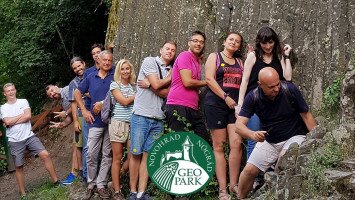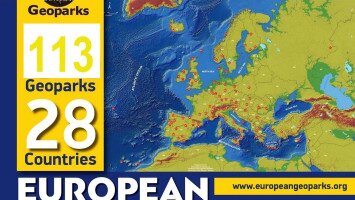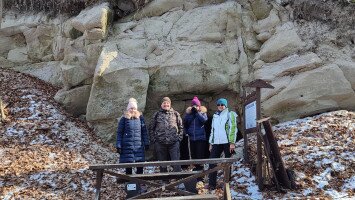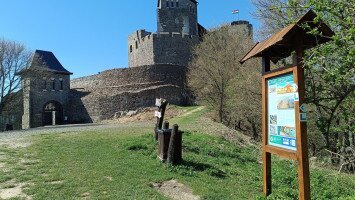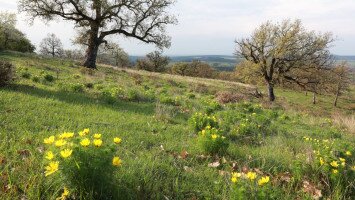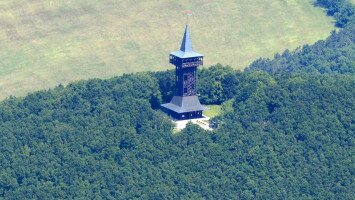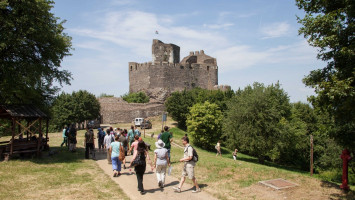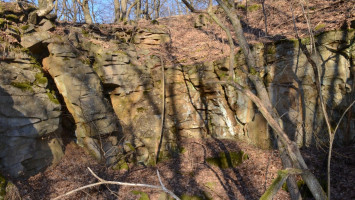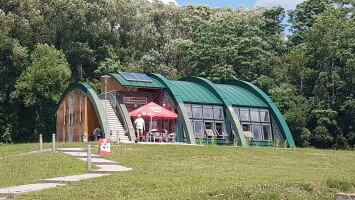
The excavations and scientific studies of the site are ongoing with new discoveries and huge potentials. Even the achievements and the history of its research of the last 180 years is a valuable heritage of the geosciences.
The scientific research of the area started in 1836 by Ferenc Kubinyi at the giant petrified pine.
It was H. Böck, who, at the base of the giant tree, originally discovered the prehistoric animal footprints in 1900. In the 1920’s, 30’s and 60’s F. Nopcsa, and later Tasnádi also enriched the Institute’s collections by excavating more footprints (Tasnádi, 1976).
Analysis of the footprints started immediately after their discovery, and it was known a hundred years ago that there were tracks of rhinoceroses, ungulates and birds.
The first scientific description of the footprints happened in 1935, in a book by O. Abel, who identified footprints of a rhinoceros, a proboscidean, cervids, an ancestral triungulate horse, a large carnivore as well as birds. Following the studies of Tasnádi, the “Ipolytarnóc” monograph of Geologica Hungarica series Palaeontologica was issued in 1985, for the Regional Committee on Mediterranean Neogene Stratigraphy (RCMNS) congress, where L. Bartkó published the geological setup, L. Hably reconstructed the fossil flora and L. Kordos identified 11 animal species based on all footprints known at the time. The taxonomic analysis of the Ipolytarnóc footprints was carried out simultaneously, and in competition, between the Hungarian Kordos (1985) and the Soviet Vialov (1985, 1986). Based on the priorities, 11 animal species were identified, all of which were new to science.
Despite the focused attention of the Neogene Congress of 1985 on Ipolytarnoc, no further development enhanced the site’s recognition till the end of the century.
In 2013 new methods were introduced focusing on shallow traces and remapping of the fossil tracks. Up to the present (2025) more than 40 vertebrate ichnotaxa have been identified, now including amphibians and reptiles, too.
Reference:
- Tuzson J.(1901) – A Tarnóczi Kövült Fa
- Koch (1903): Tarnóci cápafogak
- Noszky J (1929): Őstörténeti emlékek Ipolytarnócon
- Hámor G (1985): Foreword to the Fossils of Ipolytarnoc
- Bartkó L.(1985): Geology of Ipolytarnoc
- Hably L (1985): Plant Fossils from Ipolytarnoc
- Kordos L. (1985): Footprints of Ipolytarnoc
- Korpás L.(2003) – Ipolytarnóci paleorekonstrukciók
- Kocsis (Geol_Carpath_2007) -Shark teeth of Ipolytarnoc
- Haas & MFT(2010)- A múlt ösvényein _Ipolytarnóc fejezete
- Palfy_etal (2007 EPSL) – Dating of Miocene fossil track site
- Szarvas (2007) – Case study of the Ipolytarnoc track site
- Marton E. (2007) – Paleomagnetic study of Ipolytarnoc
- Kordos László (2008) – Ipolytarnóc, a földtörténet forgószínpada (Élet és Tudomány)
- Hagen András (2013) – Hogyan mozogtak az ipolytarnóci ősállatok
- Hagen András (2012): Ipolytarnóci ősállatok mozgássebessége
- Tasnádi Kubacska András és Ipolytarnóc
- Kordos László (2013): Ősállatok lábnyomai a vulkán fogságában (3. Évezred magazin)
- Kordos & Mészáros (2016): A medvekutya
- Kordos & Mészáros (2016): Az ipolytarnóci madárdomb lábnyomai
- Kordos & Mészáros (2017): Bird tracks of Ipolytarnoc
- Mártonné Szalay Emő (2016): Paleomágnesség Ipolytarnócon (Ipolytarnóc földtani megismerése I.kötet)
- Kocsis László (2016): Újabb eredmények az ipolytarnóci cápafogas rétegről (Ipolytarnóc földtani megismerése I.kötet)
- Kordos Et Al.(2021 GCR): Tracking Ipolytarnoc
- Karatson & (2022): Large magnitude eruption Ipolytarnoc
- Botfalvai Gábor Et Al.(2022 HB): Large-sized pentadactyl carnivore footprints from the early Miocene fossil track site at Ipolytarnóc (Hungary): 3D data presentation and ichnotaxonomical revision
- Belvedere et al (2025): Rhinoceripeda tracks from ipolytarnóc.pdf
Novohrad-Nógrád Geopark:
- Tardy &(2008): Yellowstone-tól a geoparkokig
- A Novohrad-Nógrád Geopark ismertető kiadvány
- Kincses Geopark
- Kordos &(2009)MÁFI – Nógrádi geológiai bemutatóhelyek
- Harangi Sz (2014): Volcanic tourism destinations in the Pannonian region
- Harangi Sz & (2015): The Pannonian volcano route
- João Carlos Nunes & (2022): Geoparks in Volcanic Areas in Europe
- Harangi Et Al (2023): Volcanic Volcanic Geoheritage of the Novohrad–Nógrád UNESCO Global Geopark
- Folder of touristic publications in different languages
Bükkábrány trees:
- Antalfi E & : Characteristics of Bukkabrany trees – poster
- Antalfi E & (2012): Bükkábrányi fák mikroszkópikus meghatározása
- Kazmer(2011)Bukkabrany forest structure
- Sakala(2010)Identification of fossil trunks from Bükkábrány
- Jaku_poster_ipolytarnoc_greguss
- Kázmér(2008)Bükkábrány fossil forest
- Csaszar_etal_2009_fossil_forest_paleopark_Bukkabrany
- Erdei: Bükkábrány trees (Palaeobotany 2009)
- Erdei _ etal_2007_Neogene flora development of the Pannonian domain
- PLASTDUR_bükkábrányi fák mentésére
- Plastdur_1_Conserving cypresses of Bükkábrány.pdf
- Plastdur_2_Bükkábrány trees at Ipolytarnoc
Kubinyi Ferenc:

